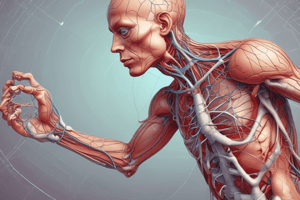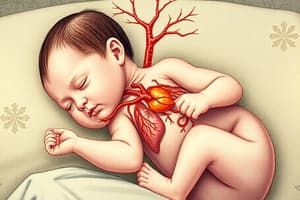Podcast
Questions and Answers
What physiological change occurs in the heart as a response to training?
What physiological change occurs in the heart as a response to training?
- Thinner heart walls
- Decreased stroke volume
- Hypertrophy of the heart walls (correct)
- Reduced cardiac output
How does aerobic training affect lactic acid accumulation in muscles?
How does aerobic training affect lactic acid accumulation in muscles?
- It increases lactic acid accumulation
- It decreases lactic acid accumulation (correct)
- It only affects lactic acid during anaerobic exercise
- It has no effect on lactic acid levels
Which changes occur in the respiratory system as a result of training?
Which changes occur in the respiratory system as a result of training?
- Increased strength of diaphragm and intercostal muscles (correct)
- Reduced lung capacity
- Decreased strength of the diaphragm and intercostal muscles
- Fewer capillaries around the alveoli
What is the average resting heart rate for an untrained individual?
What is the average resting heart rate for an untrained individual?
What determines the maximum heart rate of an individual during exercise?
What determines the maximum heart rate of an individual during exercise?
During a training session, what is the heart rate threshold for aerobic training?
During a training session, what is the heart rate threshold for aerobic training?
What role do mitochondria play in trained muscles?
What role do mitochondria play in trained muscles?
What effect does increased capillary density around alveoli have on oxygen delivery?
What effect does increased capillary density around alveoli have on oxygen delivery?
What is the primary effect of increased red blood cell count on athletic performance?
What is the primary effect of increased red blood cell count on athletic performance?
Which of the following adaptations does training not induce?
Which of the following adaptations does training not induce?
Flashcards
Heart Hypertrophy
Heart Hypertrophy
The thickening and strengthening of the heart walls.
Increased Stroke Volume
Increased Stroke Volume
More blood pumped out with each heart beat.
Decreased Resting Heart Rate
Decreased Resting Heart Rate
Lower heart rate when not exercising.
Increased Cardiac Output
Increased Cardiac Output
Signup and view all the flashcards
Increased Oxygen Delivery
Increased Oxygen Delivery
Signup and view all the flashcards
Increased Lung Capacity
Increased Lung Capacity
Signup and view all the flashcards
Mitochondria in Muscles
Mitochondria in Muscles
Signup and view all the flashcards
Aerobic Training Threshold
Aerobic Training Threshold
Signup and view all the flashcards
Anaerobic Training Threshold
Anaerobic Training Threshold
Signup and view all the flashcards
Maximum Heart Rate
Maximum Heart Rate
Signup and view all the flashcards
Study Notes
Cardiovascular Adaptations to Training
- Heart Hypertrophy: Heart walls thicken and strengthen, increasing stroke volume.
- Increased Stroke Volume: More blood pumped per heartbeat.
- Decreased Resting Heart Rate: A result of increased stroke volume.
- Increased Cardiac Output: More blood pumped per minute.
- Increased Red Blood Cells: Improved oxygen delivery to muscles.
- Increased Capillaries (Muscles & Alveoli): Enhanced gaseous exchange (oxygen and carbon dioxide).
- Reduced Lactic Acid Accumulation: More efficient oxygen delivery system.
- Larger, More Elastic Arteries: Improved blood flow.
Respiratory Adaptations to Training
- Strengthened Diaphragm & Intercostal Muscles: Increased lung capacity.
- Larger Lung Volumes: More oxygen intake.
- Increased Alveolar Capillaries: Enhanced oxygen diffusion into the blood.
Muscular Adaptations to Training
- Increased Muscle Bulk: Stronger and more powerful muscles.
- Increased Muscle Strength: Stronger bones and ligaments for injury prevention.
- Increased Mitochondria: More energy production in muscles.
- Increased Myoglobin: Increased oxygen storage in muscles.
- Increased Glycogen Storage: More glucose stored in muscles.
- Increased Lactic Acid Tolerance: Improved performance during exercise.
Heart Rate and Training
- Resting Heart Rate: Average is 72 beats per minute.
- Working Heart Rate: Increases during exercise.
- Recovery Heart Rate: Higher than resting but lower than working allows for replenishment of oxygen debt.
- Training Zone: Maintain heart rate in the target zone for at least 15 minutes.
- Maximum Heart Rate: Calculated as 220 minus age.
- Aerobic Training Threshold: 60-80% of maximum heart rate.
- Anaerobic Training Threshold: 80-90% of maximum heart rate.
Studying That Suits You
Use AI to generate personalized quizzes and flashcards to suit your learning preferences.




